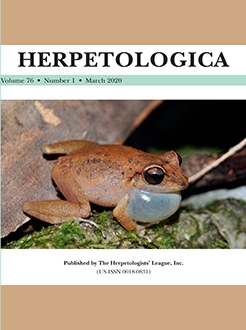Climatic and geological changes in eastern North America have shaped population history and genetic diversity in many taxa. A common finding of phylogeographic investigations is that southern populations exhibit relatively high levels of phylogeographic structure, whereas northern populations, especially those that have invaded postglacial landscapes, exhibit relatively little genetic differentiation. Here, we describe the results of a phylogeographic investigation of Eastern Red-backed Salamander (Plethodon cinereus), a species that is widely distributed throughout the northeastern United States and southeastern Canada, with roughly three quarters of its range north of the southernmost glacial extent during the last glacial maximum. To investigate patterns of genetic variation, we collected genetic samples from 202 individuals from 107 populations from across the range of P. cinereus, with denser sampling in the southern portion of the range. In total, 4486 base pairs (bp) of DNA were sequenced, including three mitochondrial DNA (mtDNA; 2239 bp) loci and three nuclear (2247 bp) loci. A mix of phylogenetic, population genetic, and clustering approaches were used to explore and summarize patterns of genetic variation. Bayesian phylogenetic analysis of mtDNA recovered six well-supported, geographically cohesive clades that increase in geographic range size from south to north, with a most recent common ancestor estimated at 1.49 million years (95% highest posterior density = 1.09–1.95). The northernmost clade possessed a horseshoe-shaped distribution, including the eastern seaboard, all or part of southeastern Canada, and Michigan, Indiana, and Ohio; thus, this clade was recovered south of the last glacial boundary in both the east and the west. Using simple population genetic tests, we showed evidence of range expansion and isolation by distance in most clades. Using the dispersal-extinction-cladogenesis biogeographic model in RevBayes, we inferred the ancestor of P. cinereus to occupy either the Blue Ridge or the Ridge and Valley physiographic province. In contrast to mtDNA, nuclear loci revealed little phylogeographic structure, and cluster analyses using the nuclear data were not well resolved. Finally, we compare our results with published and unpublished allozyme studies, and we identify several distributional and biogeographic questions that emerge from our findings.
How to translate text using browser tools
4 March 2020
Multilocus Phylogeography of Eastern Red-Backed Salamanders (Plethodon cinereus): Cryptic Appalachian Diversity and Postglacial Range Expansion
Tom Radomski,
Maggie M. Hantak,
Ashley D. Brown,
Shawn R. Kuchta
ACCESS THE FULL ARTICLE

Herpetologica
Vol. 76 • No. 1
March 2020
Vol. 76 • No. 1
March 2020
BEAST
Dispersal-extinction-cladogenesis (DEC) model
gene tree
mitochondrial DNA
nuclear DNA
Pleistocene
RevBayes




